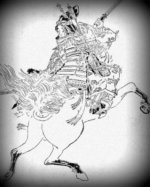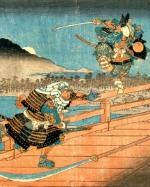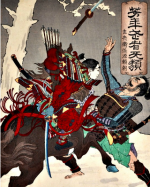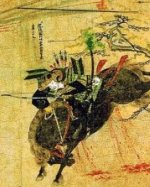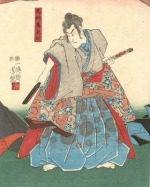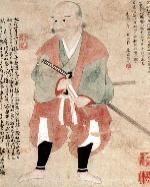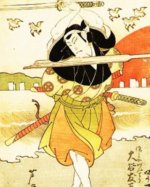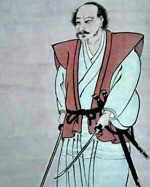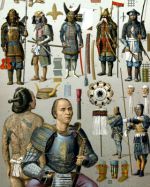The Japanese Samurai Sword
Talk the Talk
Dr. Inazo Nitobe wrote a book in English in 1900 called
Bushido: The Soul of Japan.
It explained to the Western world exactly what the ‘Way’ of the Japanese warriors of the medieval period was and how the Bushido Code influenced their lives. He stated that;
"Just as the soul of the samurai is the soul of Japan, the sword is the soul of the samurai".
While Nitobe, like so many others before and after him, did have a tendency to over-romanticise when it comes to the samurai and his sword, the poetic language used when it comes to the katana and its wielder reflects just how important the weapon was to the honour codes and culture of the warrior elite in Japan.
It explained to the Western world exactly what the ‘Way’ of the Japanese warriors of the medieval period was and how the Bushido Code influenced their lives. He stated that;
"Just as the soul of the samurai is the soul of Japan, the sword is the soul of the samurai".
While Nitobe, like so many others before and after him, did have a tendency to over-romanticise when it comes to the samurai and his sword, the poetic language used when it comes to the katana and its wielder reflects just how important the weapon was to the honour codes and culture of the warrior elite in Japan.
Walk the Walk
Masamune (pictured below) was a sword-smith of the Kamakura Period and is considered to be the best ever.
His swords were known to have the perfect balance between sharpness, strength and flexibility which was achieved by welding three bits of steel all with varying carbon content.
Masamune’s swords were so sharp that anyone who used one of his masterpieces would, so the legend goes, go mad with blood lust.
That said, other legends maintain that his swords had a deep spiritual purity and would not indiscriminately cut down the innocent and undeserving.
His swords were known to have the perfect balance between sharpness, strength and flexibility which was achieved by welding three bits of steel all with varying carbon content.
Masamune’s swords were so sharp that anyone who used one of his masterpieces would, so the legend goes, go mad with blood lust.
That said, other legends maintain that his swords had a deep spiritual purity and would not indiscriminately cut down the innocent and undeserving.
Samurai Quote
"The warrior's intention should be simply, to grasp his sword and to die".
~ Kiyomasa Kato ~
~ Kiyomasa Kato ~
%20%20article.jpg?timestamp=1369299053138) Japanese samurai swords were worn by warriors of the ruling elite during the Middle Ages right up to the modern era and acted as much as status symbols as they did weapons.
Japanese samurai swords were worn by warriors of the ruling elite during the Middle Ages right up to the modern era and acted as much as status symbols as they did weapons. They often came as a set of two, a katana which is the longer of the pair and was used to fight with and the wakizashi, a shorter sword mainly used as a backup weapon, for seppuku (ritual suicide) and for decapitating defeated enemies on the battlefield in order to present the head to a warlord.
Up to around the turn of the eighth century, Japanese warriors used Chinese-style swords which were sharp but prone to break during battle. This highlights a problem that has been faced by sword-smiths all over the world and throughout the ages; they could make a sword sharp but it would be brittle and easily snap, or they could make it tough and pliable but it would be relatively blunt.
Up to around the turn of the eighth century, Japanese warriors used Chinese-style swords which were sharp but prone to break during battle. This highlights a problem that has been faced by sword-smiths all over the world and throughout the ages; they could make a sword sharp but it would be brittle and easily snap, or they could make it tough and pliable but it would be relatively blunt.
The Beginning of Samurai Sword History
According to legend, samurai sword history began when a master smith named Amakuni noticed that the swords he made were snapping a lot during combat. He set about to solve this problem through a process of praying for inspiration and the use of trial and error, eventually realising that the secret lies in the cooling part of the sword-making process.Once the weapon had been hammered into shape, Amakuni discovered that if he covered the top of the blade with clay, the bottom edge would cool at a quicker rate making it possible to make it very sharp. The covered side would then become more flexible as a result of the slower cooling applied to it, making for a sharp, tough and flexible blade that was very difficult to break. The new type of sword became known as a tachi and was the predecessor to the very similar katana.
Great attention to detail was given not only to making the blade just right but making
other parts of the weapon such as the hilt, hand guard and scabbard works of art in their own right. They were often hand-crafted with depictions of Japanese mythology and made
from precious materials such as ivory along with gold and silver embedded onto them to enhance the elaborate decoration.
The Spiritual and Artistic Nature of the Samurai Sword
The success of an individual sword would be attributed to both great mastery by the sword-smith who crafted it, and to supernatural forces. When a new sword was made, a ritualistic process would take place with the smith often being blessed and purified by a priest beforehand. According to Inazo Nitobe who wrote about the samurai in the early twentieth century:"The sword-smith was not a mere artisan but an inspired artist and his workshop a sanctuary. Daily, he commenced his craft with prayer and purification, or, as the phrase was, ‘he committed his soul and spirit into the forging and tempering of the steel.’"
Testing Samurai Swords
Once complete, the sword would need to be tested to be sure it was worthy of being used on the battlefield. The last thing a samurai warrior needed was to find out his weapon was sub-standard when his life was depending on it so there were various methods applied to check it beforehand. The main test was to cut through rushes bundled around a bamboo core as this was considered to give the same resistance as a human body.However other methods of testing the weapons were also employed, for example, it was not uncommon to try the sword out on a corpse to be sure it could easily slice through bone or even on a criminal who had been sentenced to death. This might have been an acceptable form of execution for many prisoners, as an ancient Japanese proverb states that; “Nothing can set honour so right as the cut of a sword.”
Cohen, R. 2002. By the Sword. New York. The Modern Library. Cook, H. 1993.
McIntyre, K.J. 2000. [Video Documentary]. Soul of the Samurai. Live Art Television. Available from: https://www.youtube.com/watch?v=YbFPlAHW0nU [Accessed May 21, 2013].
Renius, A. [Internet]. 2009. The Samurai Sword. Socyberty. Available from: http://socyberty.com/history/the-samurai-sword/ [Accessed on May 21, 2013].
Turnbull, S. R. 1987. Fourth Edition. Samurai – A Military History. London. Osprey.
The Continuation of Samurai Sword History
After the Satsuma Rebellion of 1877, the Japanese government banned many aspects of samurai life but got the best swordsmen they could find to teach the newly formed police force how to use the weapons. This was the first time the country had a unified system of sword fighting and was the beginning of the art of modern kendo. Through this discipline, the techniques developed over around a thousand years of samurai sword history are preserved, along with many of the spiritual and ethical aspects that went along with learning how to wield a katana and a wakizashi.Written by Andrew Griffiths – Last updated 28/08/2023. If you like
what you see, consider following the History of Fighting on social media.
Further Reading:
A Brief Overview of Samurai Sword History. [Internet]. 2005. The Sword Buyer’s Guide. Available from: http://www.sword-buyers-guide.com/samurai-sword-history.html [Accessed on May 21, 2013].Cohen, R. 2002. By the Sword. New York. The Modern Library. Cook, H. 1993.
McIntyre, K.J. 2000. [Video Documentary]. Soul of the Samurai. Live Art Television. Available from: https://www.youtube.com/watch?v=YbFPlAHW0nU [Accessed May 21, 2013].
Renius, A. [Internet]. 2009. The Samurai Sword. Socyberty. Available from: http://socyberty.com/history/the-samurai-sword/ [Accessed on May 21, 2013].
Turnbull, S. R. 1987. Fourth Edition. Samurai – A Military History. London. Osprey.
More Samurai History
Samurai History Home
A brief overview of the history of the samurai, looking at the rise and development of the leading social class in Japan and some of the cultural traits than made the samurai warriors unique such as their weapons and their code of ethics, known as bushido.
A brief overview of the history of the samurai, looking at the rise and development of the leading social class in Japan and some of the cultural traits than made the samurai warriors unique such as their weapons and their code of ethics, known as bushido.
The Heian Period
The Heian Period was a time of major change in Japan as it saw the rise of a new warrior elite, the Samurai. The leaders of this new power would dominate the politics of the country for centuries and would even supplant the power of the Emperor, though not without a struggle.
The Heian Period was a time of major change in Japan as it saw the rise of a new warrior elite, the Samurai. The leaders of this new power would dominate the politics of the country for centuries and would even supplant the power of the Emperor, though not without a struggle.
Tomoe Gozen – Female Samurai Warrior
Tomoe Gozen is a rare example of a female Samurai warrior and is believed to have been involved in the Gempei wars (1180 – 1185). She fought alongside her Master, Minamoto Yoshinaka, though it is unclear how much of her story is actually true.
Tomoe Gozen is a rare example of a female Samurai warrior and is believed to have been involved in the Gempei wars (1180 – 1185). She fought alongside her Master, Minamoto Yoshinaka, though it is unclear how much of her story is actually true.
Yoshitsune Minamoto
The tragic tale of samurai legend Yoshitsune Minamoto. After helping his brother Yoritomo win the Genpei War and gain control of Japan, he was denied the titles and rewards he should have received for his services and was ultimately hunted down as a traitor.
The tragic tale of samurai legend Yoshitsune Minamoto. After helping his brother Yoritomo win the Genpei War and gain control of Japan, he was denied the titles and rewards he should have received for his services and was ultimately hunted down as a traitor.
The Kamakura Period
A look at the change and turmoil experienced by the ruling elite of Japan during the Kamakura Period and the Kemmu Restoration. A series of civil wars and two invasions from the Mongols saw powershifts not only between rival families, but also between the titles of the Emperor, the Shogun and the Regent.
A look at the change and turmoil experienced by the ruling elite of Japan during the Kamakura Period and the Kemmu Restoration. A series of civil wars and two invasions from the Mongols saw powershifts not only between rival families, but also between the titles of the Emperor, the Shogun and the Regent.
The Mongols vs. The Samurai
While the samurai warriors of the late thirteenth century were formidable warriors in their own right, when faced with the onslaught of the Mongol Hordes they seemed to be fated to lose. They were outclassed in every way by however things did not go according to plan for the foreign invaders.
While the samurai warriors of the late thirteenth century were formidable warriors in their own right, when faced with the onslaught of the Mongol Hordes they seemed to be fated to lose. They were outclassed in every way by however things did not go according to plan for the foreign invaders.
The Muromachi Period
The Muromachi Period was a time of turmoil in Japan that can be spilt into two separate eras. At the beginning of the period, the government was divided into two separate entities sparking the Northern and Southern Courts Era. Then, after a brief period of relative stability, the Warring States Era began.
Tsukahara Bokuden
Tsukahara Bokuden was a samurai warrior who lived in the 16th century. In his early days he exemplified what a samurai should be and was known as one of the fiercest warriors around. However in later life, Bokuden would take on a more pacifist philosophical stand point.
Tsukahara Bokuden was a samurai warrior who lived in the 16th century. In his early days he exemplified what a samurai should be and was known as one of the fiercest warriors around. However in later life, Bokuden would take on a more pacifist philosophical stand point.
The Azuchi-Momoyama Period
The Azuchi-Momoyama Period was characterised by the unification of the samurai clans after years of unrest and civil war. First, Nobunaga Oda managed to wrest control of much of the archipelago, and his successes were then built upon by Hideyoshi Toyotomi. The latter also brought social reforms to Japan, many of which would last nearly 300 years, though not all were for the better, especially for an ambitious peasant.
The Death of a Samurai
The manner in which a samurai died was very important and if possible, it would be during combat in a way that would be told in samurai stories for years to come. Failing that, he should die in some other service to his lord or if his honour depended on it, in a ritualistic suicide known as seppuku.
The manner in which a samurai died was very important and if possible, it would be during combat in a way that would be told in samurai stories for years to come. Failing that, he should die in some other service to his lord or if his honour depended on it, in a ritualistic suicide known as seppuku.
The Duels of Miyamoto Musashi
Miyamoto Musashi is one of the most acclaimed samurai that ever lived. While undertaking a warrior’s pilgrimage, he fought in over 60 duels dispatching the best swordsmen in a given area, often in fights to the death.
The Samurai at War
The main business of the samurai was war and while tactics and weapons changed through the years, the willingness to die for their lord was a constant. In return, they could gain riches and status, as well as the best of them gaining a kind of immortality by having stories told about them for centuries to come.
The main business of the samurai was war and while tactics and weapons changed through the years, the willingness to die for their lord was a constant. In return, they could gain riches and status, as well as the best of them gaining a kind of immortality by having stories told about them for centuries to come.
The images on this site are believed to be in the public domain, however, if any mistakes have been made and your copyright or intellectual rights have been breeched, please contact andrew@articlesonhistory.com.


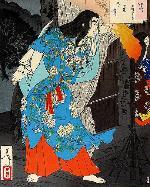
.jpg?timestamp=1582624720200)
